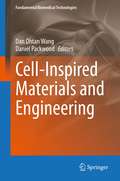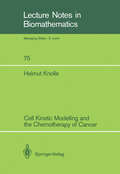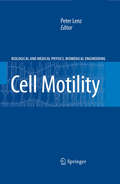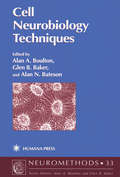- Table View
- List View
Cell Fusion: Overviews and Methods (Methods in Molecular Biology #475)
by Elizabeth H. ChenExciting work in the past decade has revealed commonalities and differences among individual cell fusion events. In Cell Fusion: Overviews and Methods, a team of leading experts provide a collection of overviews that outline our current understanding of cell fusion and methods that present classic and state-of-the-art experimental approaches in a variety of systems. Divided into two convenient parts, the volume begins with nine overviews which describe different cell fusion events in models from yeast to mammals, and it continues with thirteen chapters illustrating commonly used methods to assay cell fusion in particular systems. As a part of the highly successful Methods in Molecular Biology™ series, these methods chapters compile step-by-step, readily reproducible protocols with lists of the necessary materials and reagents, along with tips on troubleshooting and avoiding known pitfalls. Cutting-edge and user-friendly, Cell Fusion: Overviews and Methods serves as a comprehensive resource for anyone, expert or novice, interested in the fascinating biological process of cell fusion.
Cell Fusion in Health and Disease: I: Cell Fusion in Health (Advances in Experimental Medicine and Biology #713)
by Thomas Dittmar and Kurt S. S. ZänkerAlthough cell fusion is an omnipresent process in life, to date considerably less is still known about the mechanisms and the molecules being involved in this biological phenomenon in higher organisms. In Cell Fusion in Health and Disease Vol 1 & Vol 2 leading experts will present up-to-date overviews about cell fusion in physiological and patho-physiological processes, which further covers the current knowledge about cell fusion-mediating molecules. Volume 1 deals with Cell Fusion in Health and will cover aspects of cell fusion in fertilization, placentation, in C. elegans, in skeletal muscle development and tissue repair, and the use of cell fusion for cellular reprogramming and cancer vaccine development. Volume 2 focuses on Cell Fusion in Disease with a particular emphasis on the role of cell fusion in cancer development and progression. Thus, Cell Fusion in Health and Disease Vol 1 & Vol 2 represents a state-of-the-art work for researchers, physicians or professionals being interested in the biological phenomenon of cell fusion and beyond.
Cell Fusion in Health and Disease: II: Cell Fusion in Disease (Advances in Experimental Medicine and Biology #950)
by Thomas Dittmar and Kurt S. ZänkerAlthough cell fusion is an omnipresent process in life, to date considerably less is still known about the mechanisms and the molecules being involved in this biological phenomenon in higher organisms. In Cell Fusion in Health and Disease Vol 1 & Vol 2 leading experts will present up-to-date overviews about cell fusion in physiological and patho-physiological processes, which further covers the current knowledge about cell fusion-mediating molecules. Volume 1 deals with Cell Fusion in Health and will cover aspects of cell fusion in fertilization, placentation, in C. elegans, in skeletal muscle development and tissue repair, and the use of cell fusion for cellular reprogramming and cancer vaccine development. Volume 2 focuses on Cell Fusion in Disease with a particular emphasis on the role of cell fusion in cancer development and progression. Thus, Cell Fusion in Health and Disease Vol 1 & Vol 2 represents a state-of-the-art work for researchers, physicians or professionals being interested in the biological phenomenon of cell fusion and beyond.
Cell Fusions: Regulation and Control
by Lars-Inge LarssonCell fusions are important to fertilization, placentation, development of skeletal muscle and bone, calcium homeostasis and the immune defence system. Additionally, cell fusions participate in tissue repair and may be important to cancer development, progression and therapy. A large number of factors regulate cell fusions, including receptors and ligands, membrane domain organizing proteins, proteases, signaling molecules and fusogenic proteins that bring membranes close together. In the present volume, we interrogate what mechanisms that may be important to cell fusions in mammals and what mechanisms that may be shared with lower organisms and viruses. Additionally, the importance of cell fusions to the pathogenesis as well as treatment of diseases is addressed.
Cell Growth and Oncogenesis (Molecular and Cell Biology Updates)
by J. M. Tager SergioPapa DarjaKanduc PeterBannaschRapid progress has been made in our understanding of the molecular mechanisms of cell growth and oncogenesis during the past decade. This book comprises recent results on the regulation of cell growth in normal and neoplastic tissues by growth factors including hormones, and by the activation and inactivation of oncogenes and tumor suppressor genes, respectively. Special attention has been given to the presentation of the frequently neglected close correlation between changes in signal transduction and metabolism pathways during oncogenesis.
Cell Imaging Techniques: Methods And Protocols (Methods in Molecular Biology #319)
by Douglas J. Taatjes and Brooke T. MossmanA diverse collection of state-of-the-art methods for the microscopic imaging of cells and molecules. The authors cover a wide spectrum of complimentary techniques, including such methods as fluorescence microscopy, electron microscopy, atomic force microscopy, and laser scanning cytometry. Additional readily reproducible protocols on confocal scanning laser microscopy, quantitative computer-assisted image analysis, laser-capture microdissection, microarray image scanning, near-field scanning optical microscopy, and reflection contrast microscopy round out this eclectic collection of cutting-edge imaging techniques now available. The authors also discuss preparative methods for particles and cells by transmission electron microscopy.
Cell Imaging Techniques: Methods and Protocols (Methods in Molecular Biology #931)
by Douglas J. Taatjes and Jürgen RothCell Imaging is rapidly evolving as new technologies and new imaging advances continue to be introduced. In the second edition of Cell Imaging Techniques: Methods and Protocols expands upon the previous editions with current techniques that includes confocal microscopy, transmission electron microscopy, atomic force microscopy, and laser microdissection. With new chapters covering colocalization analysis of fluorescent probes, correlative light and electron microscopy, environmental scanning electron microscopy, light sheet microscopy, intravital microscopy, high throughput microscopy, and stereological techniques. Written in the highly successful Methods in Molecular Biology™ series format, chapters include introductions to their respective topics, lists of the necessary materials and reagents, step-by-step, readily reproducible laboratory protocols, and tips on troubleshooting and avoiding known pitfalls Authoritative and cutting-edge, Cell Imaging Techniques: Methods and Protocols, Second Edition is an easily accessible volume of protocols to be used with a variety of imaging-based equipment likely available in a core imaging facility.
Cell Immortalization (Progress in Molecular and Subcellular Biology #24)
by Alvaro Macieira-CoelhoThe problem of the long-term proliferation of cells is a seminal one. It has always been a hot subject in biology, a source of far-reaching hypotheses, even more so now when explanations for the mechanisms of cell prolifera tive mortality or immortality seem within our reach. A question which is still debated is whether an infinite division potential can be a normal trait or is always the result of modifications leading to abnormal cell growth and escape from homeostasis. In general, investigators have been advocates of one of the two extremes, universal limited or unlim ited normal proliferative potential. Since the long-term proliferative potential of cells concerns regulation of development, regeneration of tissues, and homeostatic control of cell growth, in brief survival of living organisms, and since the regulation of these processes is so different along the evolutionary scale, it is not surpris ing that there does not seem to be any universal trait. The question of whether cells are endowed with finite or infinite prolifera tive phenotypes has to be seen using the perspective of comparative biology.
Cell Impairment in Aging and Development (Advances in Experimental Medicine and Biology #53)
by V. Cristofalolar aging, to which this model contributes, has grown. Apart from reports on work in this almost "classical" diploid cell system, the symposium presents studies using different biological systems with results that have been rewarding as information is obtained on patterns of change that are common to more than one experimental system. Indeed, in recent years much more has been learned about the fate of all different types of intermitotic and postmitotic cells in situ. The symposium has also presented contributions dealing, not directly with aging but with early ontogeny; such information on early developmental changes should certainly shed light on some of the mechanisms involved in aging. We are cognizant of the fact that environmental influences resulting from the complexities of modern civilization may have results that only occur much later, and profoundly affect the lifespan of the organism. There remain, of course, many unanswered questions. Whether there is "physiological" as opposed to "pathological" aging; whether "old" cultures living in unchanged, although not exhausted, medium, are degenerating, not aging; what is involved when "old" fragment cultures regenerate after excision by filling the wound with "young" cells; why some tumor cells in vivo as well as in vitro die while others live; all are questions~eserving of our attention.
Cell Injury and Protection in the Gastrointestinal Tract: From Basic Sciences to Clinical Perspectives 1996
by Gy. Mózsik, L. Nagy, A. Pár and K. D. RainsfordThe scientific main programmes of these series of symposia changed from time to time following the international scientific trends. The main programmes of the First Symposium were: 1. Gastric and intestinal cytoprotection; 2. Hepatoprotection; 3. Pancreatic protection. For the second one: 1. Gastrointestinal mucosal 'cytoprotection'; 2. Liver 'cytoprotection'; 3. Pancreatic 'cytoprotection'; 4. Free radicals and scavangers; 5. Computer approach to cytoprotec tion. For the third one: 1. Basic, central, peripheral and cellular mechanisms of gastrointestinaol cytoprotection; 2. Esophagal protection; 3. Gastric protection; 4. Small intestinal injury and protection; 5. Large bowel injury and protection; 6. Liver injury and protection; 7. Pancreas injury and protection. The main scientific programmes of the Fourth International Symposium on 'Cell Injury and Protection in the Gastrointestinal Tract' are: 1. General mechanisms of gastrointestinal injury and protection; 2. Cell injury and protection in the stomach; 3. Cell injury and protection in the small intestine and in the large bowel; 4. Cell injury and protection in the liver and pancreas; 5. Cell injury and protection of the premalignant status and malignant diseases in the gastrointestinal tract. The presented papers are published in this book. The abstracts of this meeting were published in Digestive Diseases and Sciences, and we record appreciation of the Editor ofthatjoumal for their publication. Some of the papers published here have appeared in Inflammopharmacology 1996;4:331-398.
Cell-Inspired Materials and Engineering (Fundamental Biomedical Technologies)
by Daniel Packwood Dan Ohtan WangThis book highlights cutting-edge studies in the development of cell-inspired biomaterials and synthetic materials that manipulate cell functions and provide the next generation with contemporary tools for treating complex human diseases. It explores the convergence of synthetic materials with cell and molecular biology and surveys how functional materials, when patterned with spatial and temporal precision, can be used effectively to maintain cell proliferation and phenotype in vitro, to trigger specific cell functions, and to redirect cell-fate decisions. Human stem cells are a frequently discussed subject in this book. This is an ideal book for students, cell biologists, researchers interested in interdisciplinary research, and biomedical engineers. This book also: Highlights successfully developed technologies in cell engineering that make possible new therapeutic development for previously untreatable conditions Covers topics including bio-inspired micro patterning, DNA origami technology, synthetic NOS inspired by compartmentalized signaling in cells, and light-induced depolarization of the cell membrane Illustrates in detail the use of stem cells and synthetic scaffolds to model ethically sensitive embryonic tissues and organs
Cell Interactions in Visual Development (The Cell and Developmental Biology of the Eye)
by S. Robert Hilfer Joel SheffieldThe eye has fascinated scientists from the earliest days of biological in vestigation. The diversity of its parts and the precision of their interaction make it a favorite model system for a variety of developmental studies. The eye is a particularly valuable experimental system not only because its tissues provide examples of fundamental processes, but also because it is a prominent and easily accessible structure at very early embryonic ages. In order to provide an open forum for investigators working on all aspects of ocular development, a series of symposia on ocular and visual devel opment was initiated in 1973. A major objective of the symposia has been to foster communication between the basic research worker and the clinical community. It is our feeling that much can be learned on both sides from this interaction. The idea for an informal meeting allowing maximum ex change of ideas originated with Dr. Leon Candeub, who supplied the nec essary driving force that made the series a reality. Each symposium has concentrated on a different aspect of ocular development. Speakers have been selected to approach related topics from different perspectives.
Cell Kinetic Modelling and the Chemotherapy of Cancer (Lecture Notes in Biomathematics #75)
by Helmut KnolleDuring the last 30 years, many chemical compounds that are active against tumors have been discovered or developed. At the same time, new methods of testing drugs for cancer therapy have evolved. nefore 1964, drug testing on animal tumors was directed to observation of the incfease in life span of the host after a single dose. A new approach, in which the effects of multiple doses on the proliferation kinetics of the tumor in vivo as well as of cell lines in vitro are investigated, has been outlined by Skipper and his co-workers in a series of papers beginning in 1964 (Skipper, Schabel and Wilcox, 1964 and 1965). They also investigated the influence of the time schedule in the treatment of experimental tumors. Since the publication of those studies, cell population kinetics cannot be left out of any discussion of the rational basis of chemotherapy. When clinical oncologists began to apply cell kinetic concepts in practice about 15 years ago, the theoretical basis was still very poor, in spite of Skipper's progress, and the lack of re levant cytokinetic and pharmacologic data was apparent. Subsequently, much theoretical work has been done and many cell kinetic models have been elaborated (for a review see Eisen, 1977).
Cell Kinetics of the Inflammatory Reaction (Current Topics in Pathology #79)
by D. O. Adams A. Akbar H. B. Benestad D. Campana L. Enerbäck S. Fossum T. A. Hamilton O. H. Iversen G. Janossy O. D. Laerum P.J.L. Lane Y. J. Liu I.C.M. MacLennan K. Norrby S. Oldfield R. Van Furth J.L. van LanckerThe European Study Group for Cell Proliferation held its XVth Meet ing at Sundvolden, Norway, in September 1987. The program included a symposium on the cell kinetics of the in flammatory reaction, with invited speakers. This volume of Current Topics in Pathology contains the manuscripts submitted by the speak ers. Inflammation is a very broad area, and the cell kinetics of the inflammatory reaction comprises a large number of topics. A full cover age would fill more than one book. This volume therefore contains only a few of the important aspects of the cell kinetics of the inflammatory reaction. It is hoped that it will serve as inspiration for further research in this important area. Inflammatory diseases are even more important than cancer, and there is a great need for a more detailed information about inflammation. OLAV HILMAR IVERSEN Contents Chapter I The Cell Kinetics of the Inflammatory Reaction. Introduction and Overview.
Cell Line Development (Cell Engineering #6)
by Mohamed Al-RubeaiMammalian cell lines command an effective monopoly for the production of therapeutic proteins that require post-translational modifications. This unique advantage outweighs the costs associated with mammalian cell culture, which are far grater in terms of development time and manufacturing when compared to microbial culture. The development of cell lines has undergone several advances over the years, essentially to meet the requirement to cut the time and costs associated with using such a complex hosts as production platforms. This book provides a comprehensive guide to the methodology involved in the development of cell lines and the cell engineering approach that can be employed to enhance productivity, improve cell function, glycosylation and secretion and control apoptosis. It presents an overall picture of the current topics central to expression engineering including such topics as epigenetics and the use of technologies to overcome positional dependent inactivation, the use of promoter and enhancer sequences for expression of various transgenes, site directed engineering of defined chromosomal sites, and examination of the role of eukaryotic nucleus as the controller of expression of genes that are introduced for production of a desired product. It includes a review of selection methods for high producers and an application developed by a major biopharmaceutical industry to expedite the cell line development process. The potential of cell engineering approch to enhance cell lines through the manipulation of single genes that play important roles in key metabolic and regulatory pathways is also explored throughout.
Cell Membrane Nanodomains: From Biochemistry to Nanoscopy
by Alessandra Cambi Diane S. LidkeCell Membrane Nanodomains: From Biochemistry to Nanoscopy describes recent advances in our understanding of membrane organization, with a particular focus on the cutting-edge imaging techniques that are making these new discoveries possible. With contributions from pioneers in the field, the book explores areas where the application of these novel
Cell Migration in Inflammation and Immunity: Methods and Protocols (Methods in Molecular Biology #239)
by Daniele D’Ambrosio and Francesco SinigagliaChemokines and their receptors play a central role in the pathogenesis of numerous, perhaps all, acute and chronic inflammatory diseases. About 50 distinct chemokines produced by a variety cell types and tissues either c- stitutively or in response to inflammatory stimuli are involved in a plethora of biological processes. These small secreted proteins exert their exquisitely variegated functions upon binding to a family of seven-transmembrane spanning G-protein coupled receptors (GPCRs) composed of almost 20 distinct entities. The biological activities of chemokines range from the control of leukocyte trafficking in basal and inflammatory conditions to the regulation of hema- poiesis, angiogenesis, tissue architecture, and organogenesis. The basis for such diversified activities rests, on one hand, upon the ubiquitous nature of chemokine production and chemokine receptor expression. Virtually every cell type can produce chemokines and expresses a unique combination of chemokine receptors. On the other hand, chemokine receptors make use of a flexible and complex network of intracellular signaling machineries that can regulate a variety of cellular functions ranging from cell migration, growth, and differentiation to death. As knowledge of the size of chemokine and chemokine receptor families rapidly reaches completeness, much is still to be uncovered in terms of fu- tional architecture of the chemokine system. The disparity between the large number of chemokines and that smaller number of receptors is balanced by the promiscuity in ligand–receptor interactions, with multiple chemokines binding to the same receptor and several chemokines binding to more than one receptor.
Cell & Molecular Biology of Prostate Cancer: Updates, Insights and New Frontiers (Advances in Experimental Medicine and Biology #1095)
by Heide SchattenThis volume covers classic and modern cell and molecular biology of prostate cancer, as well as novel biomarkers, inflammation, centrosome pathologies, microRNAs, cancer initiation novel biomarkers, inflammation, centrosome pathologies, microRNAs, cancer initiation and genetics, epigenetics, mitochondrial dysfunctions and apoptosis, cancer stem cells, angiogenesis and progression to metastasis, and treatment strategies including clinical trials related to prostate cancer. Cell & Molecular Biology of Prostate Cancer is one of two companion books comprehensively addressing the biology and clinical aspects of prostate cancer. Prostate Cancer: Molecular & Diagnostic Imaging and Treatment Stategies, the companion volume, discusses both classic and the most recent imaging approaches including analysis of needle biopsies, applications of nanoparticle probes and peptide-based radiopharmaceuticals for detection, early diagnosis and treatment of prostate cancer. Taken together, these volumes form one comprehensive and invaluable contribution to the literature.
Cell Motility (Biological and Medical Physics, Biomedical Engineering)
by Peter LenzA much-needed work that provides an authoritative overview of the fundamental biological facts, theoretical models, and current experimental developments in this fascinating area. Cell motility is fundamentally important to a number of biological and pathological processes. The main challenge in the field of cell motility is to develop a complete physical description on how and why cells move. For this purpose new ways of modeling the properties of biological cells have to be found – and this volume is a major stepping-stone along the way.
Cell Motility in Cancer Invasion and Metastasis (Cancer Metastasis - Biology and Treatment #8)
by Alan WellsCancer Morbidity and mortality result from invasive and metastatic spread. Currently, no therapies are aimed at the underlying mechanisms that enable this progression due to only nascent recognition of the distinct biology which occurs only during tumor dissemination. Recent advances have highlighted the central role of cell motility during the dynamic and transient process of tumor invasion and metastasis. This book includes state-of-the-art updates by international leaders in these studies. Chapters first present the novel model systems that enable new investigations and insights. Chapters then describe in depth the key processes and molecules that may be therapeutically targeted. Finally, the role of cell motility and its signals is explored in a number of key tumor types. This compilation should be useful to researchers in basic and translational oncology as well as those developing novel agents to prevent tumor invasion and metastasis.
Cell Neurobiology Techniques (Neuromethods #33)
by Alan A. Boulton, Glen B. Baker and Alan N. BatesonThe cutting-edge techniques detailed here include those that are particularly popular in multidisciplinary neuroscience research. There are readily reproducible methods for establishing neural cell cultures, measuring enzymes and their inhibitors, and using quantitative autoradiography to study monoamine uptake sites and receptors in the brain. Additional methods cover the use of flow cytometry to study developmental neurobiology, applications of magnetic resonance spectroscopy (MRS) to human brain metabolism, and the study of drug metabolism. Together with its companion volumes, In Vivo Neuromethods and In Vitro Neurochemical Techniques, all three cutting-edge works will prove exceptionally useful to those basic and clinical neuroscientists who want to expand the range of their current research or develop competence in complementary methods.
Cell Polarity 1: Biological Role and Basic Mechanisms
by Klaus EbnetThis work provides a state-of-the art overview on the most relevant aspects of cell polarity.Volume 1 addresses cell polarity and cell migration (front-rear polarity), cell polarity and barrier formation (apico-basal polarity) and neuronal polarity. It particularly focuses on cell polarity at the molecular level and the underlying molecular mechanisms. It also elaborates the common principles and mechanisms that regulate cellular polarization in different cell types and contexts.Both volumes are intended for professors, group leaders and researchers in cell biology as well as medical professionals in the fields of anatomy, cell biology, physiology, pathology and tumor biology.
Cell Polarity 2: Role in Development and Disease
by Klaus EbnetThis work provides a state-of-the art overview on the most relevant aspects of cell polarity.Volume 2 discusses the physiological and pathophysiological relevance of cell polarity. It especially focuses on pathophysiological conditions in which one or several aspects of cell polarity are impaired, and in which a loss of cell polarity possibly contributes to disease (e.g. epithelial-to-mesenchymal transition in cancer, role of polarity proteins in cancer). Both volumes are intended for professors, group leaders and researchers in cell biology as well as for medical professionals working in anatomy, cell biology, physiology, pathology and tumor biology.
























